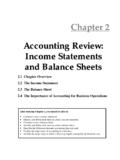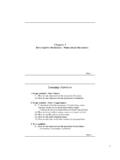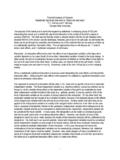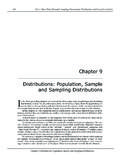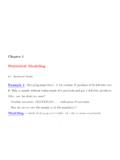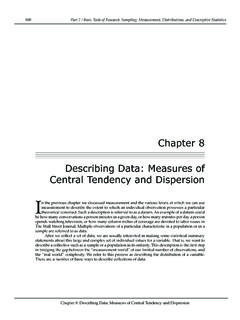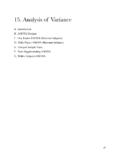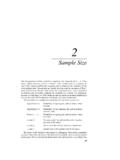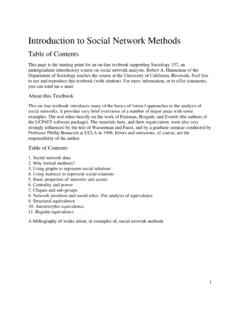Transcription of Chapter 7 Sampling and Sampling Distributions
1 Chapter 7. Sampling and Sampling Distributions Slide 1. Learning objectives 1. Understand Simple Random Sampling 2. Understand Point Estimation and be able to compute point estimates 3. Understand Sampling distribution of x 4. Understand Sampling distribution of p 5. Understand properties of Point Estimators 6. Understand other Sampling Methods Slide 2. 1. Statistical Inference A primary purpose of statistical inference is to develop estimates and test hypotheses about population parameters using information contained in a sample. A parameter is a numerical characteristic of a population . ( , mean and variance). With proper Sampling methods, the sample results can provide good estimates of the population characteristics. Slide 3. Simple random Sampling Simple Random Sampling Point estimation Sampling distribution of x Sampling distribution of p Properties of point estimators Other Sampling methods Simple Random Sampling Finite population (N) Infinite population Probability of selecting any N is unknown.
2 One data point = 1/N. Without replacement 1. From the population With replacement 2. Selected independently Slide 4. 2. Simple random Sampling Point Estimation Point estimation Sampling distribution of x Sampling distribution of p Properties of point estimators Other Sampling methods In point estimation we use the data from the sample to compute a value of a sample statistic that serves as an estimate of a population parameter. We refer to x as the point estimator of the population mean . s is the point estimator of the population standard deviation . p is the point estimator of the population proportion p. Slide 5. Simple random Sampling Sampling Error Point estimation Sampling distribution of x Sampling distribution of p Properties of point estimators Other Sampling methods n We cannot expect sample statistics to exactly equal the parameters n The absolute value of the difference between an unbiased point estimate and the corresponding population parameter is called the Sampling error.
3 ( , | x | ). n Sampling error is the result of using a subset of the population (the sample), and not the entire population . n Statistical methods can be used to make probability statements about the size of the Sampling error. Slide 6. 3. Simple random Sampling Sampling distribution of x Point estimation Sampling distribution of x Sampling distribution of p Properties of point estimators Other Sampling methods n Process of Statistical Inference population A simple random sample with mean of n elements is selected =? from the population . The value of x is used to The sample data make inferences about provide a value for the value of . the sample mean x . Slide 7. Simple random Sampling Sampling distribution of x Point estimation Sampling distribution of x Sampling distribution of p Properties of point estimators Other Sampling methods The Sampling distribution of x is the probability distribution of all possible values of the sample mean x.
4 Expected Value of x E( x ) = . where: = the population mean Slide 8. 4. Simple random Sampling Sampling distribution of x Point estimation Sampling distribution of x Sampling distribution of p Properties of point estimators Other Sampling methods Standard Deviation of x Finite population Infinite population N n . x = ( ) x =. n N 1 n A finite population is treated as being infinite if n/N < .05. ( N n ) / ( N 1) is the finite correction factor. x is referred to as the standard error of the mean. Slide 9. Simple random Sampling Form of the Sampling distribution of x Point estimation Sampling distribution of x Sampling distribution of p Properties of point estimators Other Sampling methods If we use a large (n > 30) simple random sample, the central limit theorem enables us to conclude that the Sampling distribution of x can be approximated by a normal distribution .
5 Figure on page 273. When the simple random sample is small (n < 30), the Sampling distribution of x can be considered normal only if we assume the population has a normal distribution . Slide 10. 5. Simple random Sampling Point estimation Sampling distribution of x Sampling distribution of x Sampling distribution of p Properties of point estimators Other Sampling methods for EAI example (section ). Sampling distribution 4000. of x x = = = n 30. x E( x ) = $51,800. Slide 11. Simple random Sampling Point estimation Sampling distribution of x Sampling distribution of x Sampling distribution of p Properties of point estimators Other Sampling methods for EAI example (section ). What is the probability that a simple random sample of 30 EAI managers will provide an estimate of the population mean annual salary that is within +/ $500.
6 Of the actual population mean ? In other words, what is the probability that x will be between 52,300 and 51,300? Slide 12. 6. Simple random Sampling Practical value of sample distribution Point estimation Sampling distribution of x Sampling distribution of p Properties of point estimators Other Sampling methods EAI example Sampling distribution x = of x Area = .5034. x 51,300 51,800 52,300. Slide 13. Relationship Between the Sample Size Simple random Sampling Point estimation Sampling distribution of x Sampling distribution of p Properties of point estimators Other Sampling methods and the Sampling distribution of x n Suppose we select a simple random sample of 100. managers instead of the 30 originally considered. n E(x) = regardless of the sample size. In our example, E(x) remains at 51,800.
7 N Whenever the sample size is increased, the standard error of the mean xx is decreased. With the increase in the sample size to n = 100, the standard error of the mean is decreased to: 4000. x = = = 400. n 100. Slide 14. 7. Relationship Between the Sample Size Simple random Sampling Point estimation Sampling distribution of x Sampling distribution of p Properties of point estimators Other Sampling methods and the Sampling distribution of x With n = 100, x = 400. With n = 30, x = x E(x ) = 51,800. Slide 15. Simple random Sampling In-class exercise Point estimation Sampling distribution of x Sampling distribution of p Properties of point estimators Other Sampling methods n #18 ( ). n #19 ( ). Slide 16. 8. Simple random Sampling Sampling distribution of p Point estimation Sampling distribution of x Sampling distribution of p Properties of point estimators Other Sampling methods n Making Inferences about a population Proportion population A simple random sample with proportion of n elements is selected p=?
8 From the population . The value of p is used The sample data to make inferences provide a value for the about the value of p. sample proportion p. Slide 17. Simple random Sampling Sampling distribution of p Point estimation Sampling distribution of x Sampling distribution of p Properties of point estimators Other Sampling methods The Sampling distribution of p is the probability distribution of all possible values of the sample proportion p . Expected Value of p E( p) = p where: p = the population proportion Slide 18. 9. Simple random Sampling Sampling distribution of p Point estimation Sampling distribution of x Sampling distribution of p Properties of point estimators Other Sampling methods Standard Deviation of p Finite population Infinite population p (1 p ) N n p (1 p ). p = p =. n N 1 n p is referred to as the standard error of the proportion.
9 Slide 19. Simple random Sampling Form of the Sampling distribution of p Point estimation Sampling distribution of x Sampling distribution of p Properties of point estimators Other Sampling methods The Sampling distribution of p can be approximated by a normal distribution whenever the sample size is large. The sample size is considered large whenever these conditions are satisfied: np > 5 and n(1 p) > 5. Slide 20. 10. Simple random Sampling Form of the Sampling distribution of p Point estimation Sampling distribution of x Sampling distribution of p Properties of point estimators Other Sampling methods For values of p near .50, sample sizes as small as 10. permit a normal approximation. With very small (approaching 0) or very large (approaching 1) values of p, much larger samples are needed. Slide 21.
10 Simple random Sampling Practical value of Sampling distribution of p Point estimation Sampling distribution of x Sampling distribution of p Properties of point estimators Other Sampling methods n What is the probability that a simple random sample of 30 applicants will provide an estimate of the population proportion of managers who participated in the training program within plus or minus .05 of the actual population proportion? n That is, what is the probability of obtaining a sample with a sample proportion p between .55 and .65. Slide 22. 11. Simple random Sampling Sampling distribution of p Point estimation Sampling distribution of x Sampling distribution of p Properties of point estimators Other Sampling methods Sampling p = .0894. distribution of p Area = .4246. p .55 .60 .65. Slide 23.

